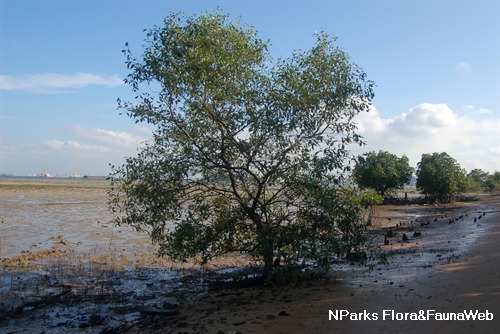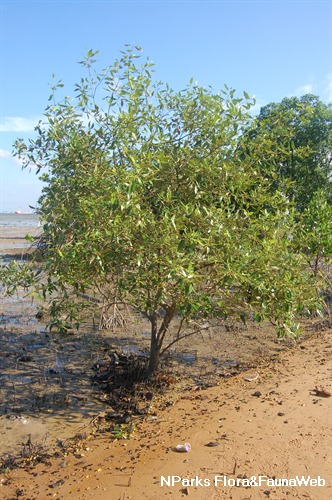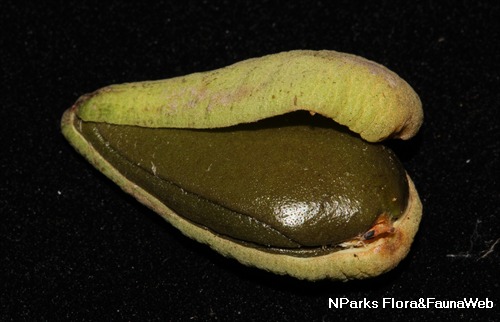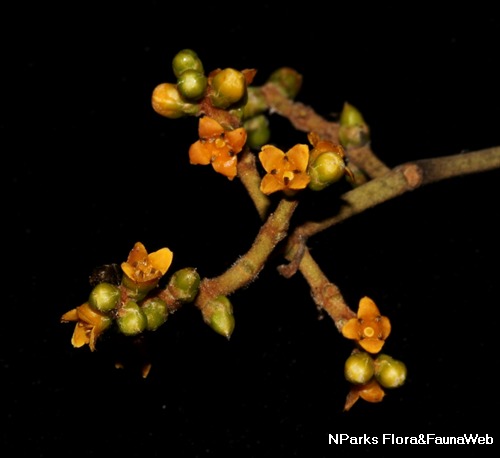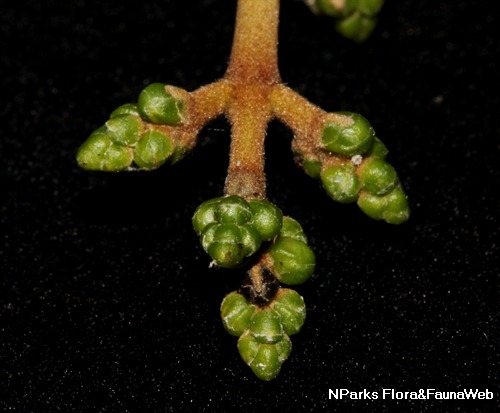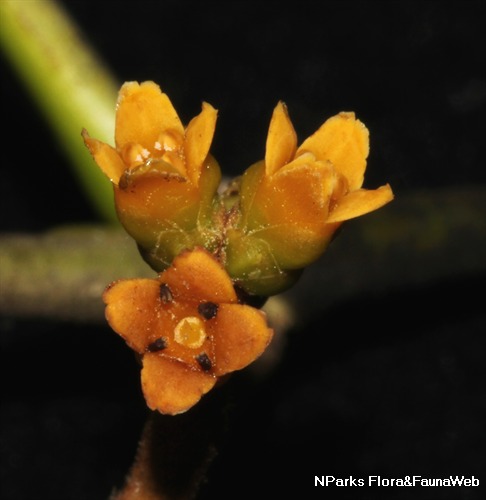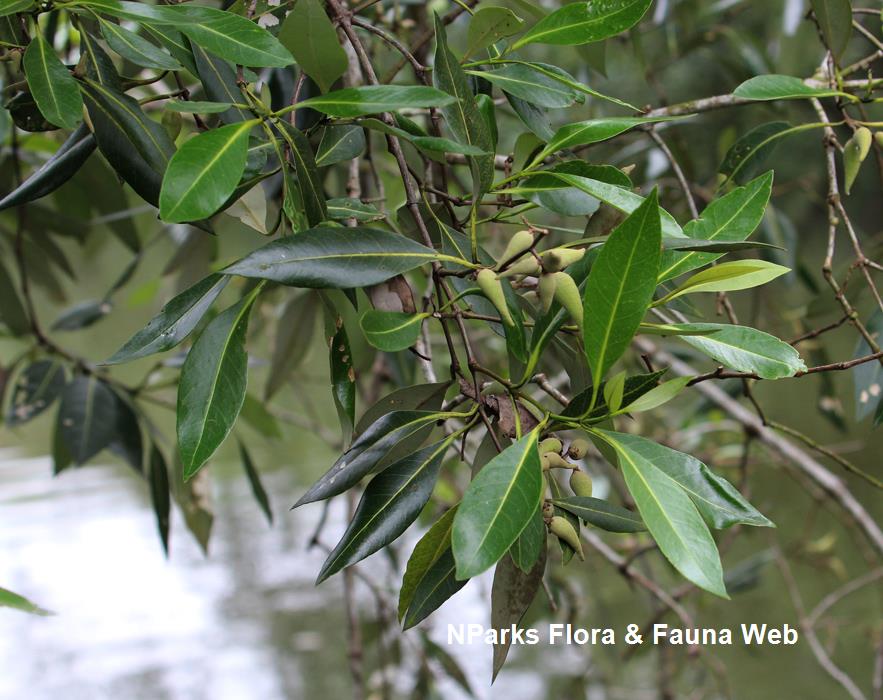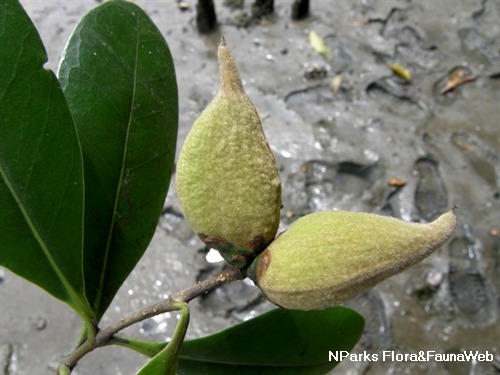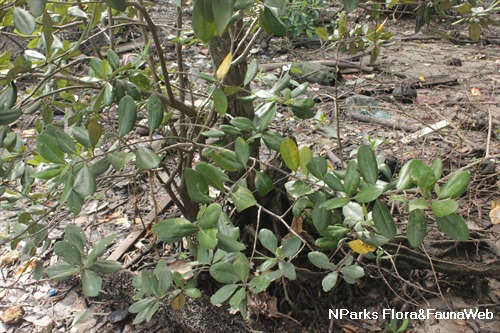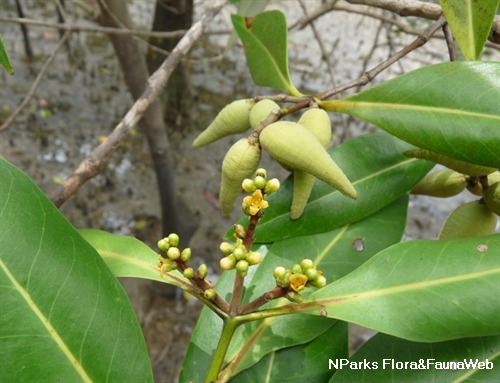
Back
Avicennia alba Blume
| Family Name: | Acanthaceae |
| Common Name: | Api Api Putih, Api Api |
Avicennia alba, also known as Api Api Putih, is an iconic tree of the mangrove forest. Standing at 20 m tall, the leaves excrete salt due to presence of salt glands. The tree develops pencil-like pneumatophores that protrude out of the soil allowing root respiration in the anaerobic muddy soil.
Name
Classifications and Characteristics
| Plant Division | Angiosperms (Flowering Seed Plants) (Dicotyledon) |
|---|---|
| Plant Growth Form | Tree (Medium (16m-30m)) |
| Lifespan (in Singapore) | Perennial |
| Mode of Nutrition | Autotrophic |
| Maximum Height | 20 m |
Biogeography
| Native Distribution | South East Asia, including Singapore, Australia and the Pacific islands. |
|---|---|
| Native Habitat | Shoreline (Mangrove Forest) |
| Preferred Climate Zone | Tropical, Sub-Tropical / Monsoonal |
| Local Conservation Status | Native to Singapore (Least Concern (LC)) |
Description and Ethnobotany
| Growth Form | Medium to large tree growing up to 20 m. |
|---|---|
| Trunk | Smooth, brownish black bark. |
| Roots | Extensive lateral root system stretching just below the soil surface with pencil-like breathing roots, also known as pneumatophores, sticking vertically out of the muddy ground to take in oxygen. Pneumatophores may grow up to a height of 15 - 20 cm. |
| Foliage | Oblong to lanceolate pointed leaves, smooth, glossy-green above and very pale under, 15 by 5 cm. Upper surface is covered with many glandular dots, able to excrete salt due to presence of salt glands in the leaves. |
| Flowers | Yellow to orange flowers measuring 3 - 4 mm across, and usually in 10 - 30 flowered clusters that are 1.5 - 3 cm long. Upper half of ovary is usually hairy. |
| Fruit | Pale green in colour, egg-shaped with a broad base and a pronounced beak, measuring up to 4 cm. All Avicennia spp. exhibits crytovivipary, in which the embryo germinates within the fruit but does not enlarge sufficiently to break through the fruit wall. |
| Habitat | Usually found on newly-formed mud banks on the seaward side of mangrove forests. Avicennia spp. are usually pioneer species in newly formed mangrove forests. |
| Etymology | Alba and putih, which means white in Latin and Malay respectively, are both used to describe the under side colour of the leaves. |
| Ethnobotanical Uses | Edible Plant Parts : Edible Fruits Medicinal:
Based on research on the effects of Avicennia alba on animals, it has these medicinal properties: antidiabetic, anti-inflammatory and analgesic <2>. Timber & Products: Wood is used to build houses, furniture and boats. Bark can be used for tanning leather. |
Landscaping Features
| Landscape Uses | Coastal, Riverine |
|---|
Fauna, Pollination and Dispersal
| Fauna Pollination Dispersal Associated Fauna | Moth Food Plant |
|---|---|
| Pollination Method(s) | Biotic (Fauna) |
| Seed or Spore Dispersal | Abiotic (Water) |
Plant Care and Propagation
| Light Preference | Full Sun, Semi-Shade |
|---|---|
| Water Preference | Lots of Water, Moderate Water |
| Plant Growth Rate | Moderate |
| Rootzone Tolerance | Moist Soils, Waterlogged Soils (Drains Site), Saline Soils / Salt Spray |
| Potential Problems | Sooty mould and Avicennia seed moth. |
| Propagation Method | Viviparious Propagule |
Foliar
| Foliage Retention | Evergreen |
|---|---|
| Mature Foliage Colour(s) | Cream / Off-White, Green |
| Mature Foliage Texture(s) | Glossy / Shiny |
| Foliar Type | Simple / Unifoliate |
| Foliar Arrangement Along Stem | Opposite |
| Foliar Attachment to Stem | Petiolate |
| Foliar Shape(s) | Non-Palm Foliage (Lanceolate) |
| Foliar Venation | Pinnate / Net |
| Foliar Margin | Entire |
| Foliar Base | Acute |
| Mature Foliage Colour(s) Remarks | Greenish on the top side of leaf, whitish on the under side of leaf. |
Floral (Angiosperm)
| Flower & Plant Sexuality | Bisexual Flowers |
| Flower Colour(s) | Yellow / Golden |
|---|---|
| Flower Grouping | Cluster / Inflorescence |
Fruit, Seed and Spore
| Mature Fruit Colour(s) | Green - Light Green |
|---|---|
| Mature Fruit Texture(s) | Leathery |
References
| References | <1> Bandaranayake, W.M. (1998) Traditional and Medicinal Uses of Mangroves. Mangroves and Salt Marshes 2: 133-148. <2> Mitra, S., et. al. (2022). Pharmacological potential of Avicennia alba leaf extract: An experimental analysis focusing on antidiabetic, anti-inflammatory, analgesic and antidiarrheal activity. BioMed Research International: 1-10. |
|---|
Image Repository
Others
| Master ID | 1971 |
|---|---|
| Species ID | 3263 |
| Flora Disclaimer | The information in this website has been compiled from reliable sources, such as reference works on medicinal plants. It is not a substitute for medical advice or treatment and NParks does not purport to provide any medical advice. Readers should always consult his/her physician before using or consuming a plant for medicinal purposes. |

